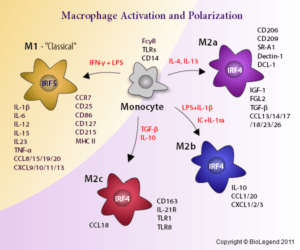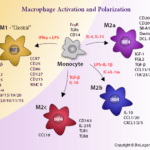
Macrophage polarisation M1 vs M2. Source: BioLegend
Alveolar macrophages (AM) play an important role in regulating immune responses in the lung. Macrophages can be categorised as either classically (M1) or alternatively (M2) activated, defined by their ability to induce inflammatory antimicrobial or anti-inflammatory immune responses, respectively. Whether AM’s also exhibit this clear dichotomy of polarisation is not well defined.
Collaboration between researchers from the United Kingdom and Malawi, aimed to investigate the polarisation of AMs detected in bronchoalveolar lavage (BAL). Studies have shown that live pneumococcal challenge and HIV infection alters the alveolar microenvironment, resulting in increased CD4+ Th17 cells and disruption of alveolar cytokine environment. Whether this microbial induced alteration also extends to AM phenotype is not well defined. Thus, BAL samples were obtained from individuals (i) the UK whom were either colonised with Streptococcus pneumoniae or not; and (ii) Malawi whom were HIV infected or not, to determine the impact of bacteria and virus, respectively.
Polarisation of macrophages can be determined using the markers CD206 and CD86, where the M1-phenotype is defined CD206loCD86hi and M2-phenotype as CD206hiCD86lo. Additionally, M1 macrophages express high levels of CD80, CD64 and HLA-DR. Surprisingly, regardless of geographical location and microbial exposure majority of AMs were predominantly CD206hiCD86hi. Further, irrespective Streptococcus pneumoniae exposure AMs detected expressed high levels of CD80, CD64 and HLA-DR, suggestive of a M1-phenotype. However, high expression of CD206 illustrates that AMs express a hybrid phenotype.
In summary, Mitsi et al., showed that alveolar macrophages express a hybrid M1/M2 macrophage phenotype. This contributes to the increasing evidence that in vivo macrophages polarisation is not static but variable. The study also highlights the need for further transcriptomic and functional characterisation of this M1/M2 alveolar macrophage phenotype.
Article: Mitsi et al., 2018. Human alveolar macrophages predominately express combined classical M1 and M2 surface markers in steady state. Respiratory Research
Article by Cheleka AM Mpande
